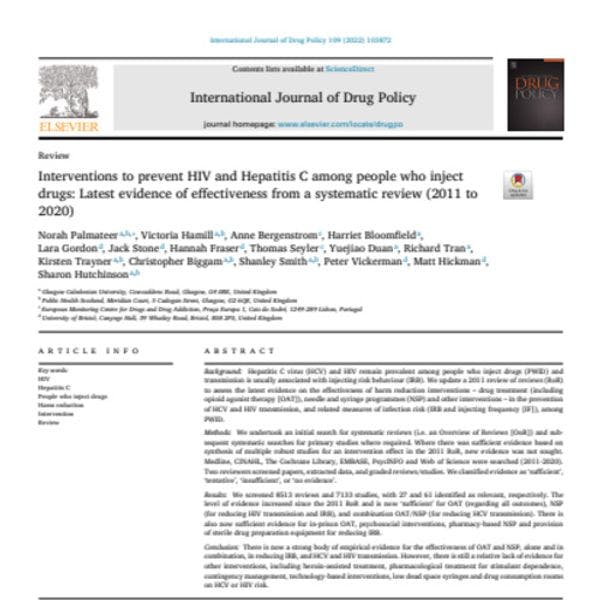Interventions pour prévenir le VIH et l'hépatite C chez les personnes consommant des drogues par injection : Dernières preuves d'efficacité issues d'une revue systématique
Palmateer et al. confirment la valeur des principales interventions de réduction des risques pour réduire la transmission du VHC et du VIH, et identifient les lacunes restantes dans la base de preuves pour une série d'interventions sanitaires. Pour en savoir plus, en anglais, veuillez lire les informations ci-dessous.
By Norah Palmateer, Victoria Hamill, Anne Bergenstrom, Harriet Bloomfield, Lara Gordon, Jack Stone, Hannah Fraser, Thomas Seyler, Yuejiao Duan, Richard Tran, Kirsten Trayner, Christopher Biggama, Shanley Smitha, Peter Vickerman, Matt Hickman, Sharon Hutchinson
Highlights
- A literature review found sufficient evidence that, among people who inject drugs:
- Opioid agonist therapy can reduce HCV and HIV transmission.
- Needle/syringe programmes can reduce HIV transmission.
- Opioid agonist therapy and needle/syringes combined can reduce HCV transmission.
- There is still a lack of evidence for other interventions on HCV or HIV risk.
Abstract
Background
Hepatitis C virus (HCV) and HIV remain prevalent among people who inject drugs (PWID) and transmission is usually associated with injecting risk behaviour (IRB). We update a 2011 review of reviews (RoR) to assess the latest evidence on the effectiveness of harm reduction interventions – drug treatment (including opioid agonist therapy [OAT]), needle and syringe programmes (NSP) and other interventions – in the prevention of HCV and HIV transmission, and related measures of infection risk (IRB and injecting frequency [IF]), among PWID.
Methods
We undertook an initial search for systematic reviews (i.e. an Overview of Reviews [OoR]) and subsequent systematic searches for primary studies where required. Where there was sufficient evidence based on synthesis of multiple robust studies for an intervention effect in the 2011 RoR, new evidence was not sought. Medline, CINAHL, The Cochrane Library, EMBASE, PsycINFO and Web of Science were searched (2011-2020). Two reviewers screened papers, extracted data, and graded reviews/studies. We classified evidence as ‘sufficient’, ‘tentative’, ‘insufficient’, or ‘no evidence’.
Results
We screened 8513 reviews and 7133 studies, with 27 and 61 identified as relevant, respectively. The level of evidence increased since the 2011 RoR and is now ‘sufficient’ for OAT (regarding all outcomes), NSP (for reducing HIV transmission and IRB), and combination OAT/NSP (for reducing HCV transmission). There is also now sufficient evidence for in-prison OAT, psychosocial interventions, pharmacy-based NSP and provision of sterile drug preparation equipment for reducing IRB.
Conclusion
There is now a strong body of empirical evidence for the effectiveness of OAT and NSP, alone and in combination, in reducing IRB, and HCV and HIV transmission. However, there is still a relative lack of evidence for other interventions, including heroin-assisted treatment, pharmacological treatment for stimulant dependence, contingency management, technology-based interventions, low dead space syringes and drug consumption rooms on HCV or HIV risk.
